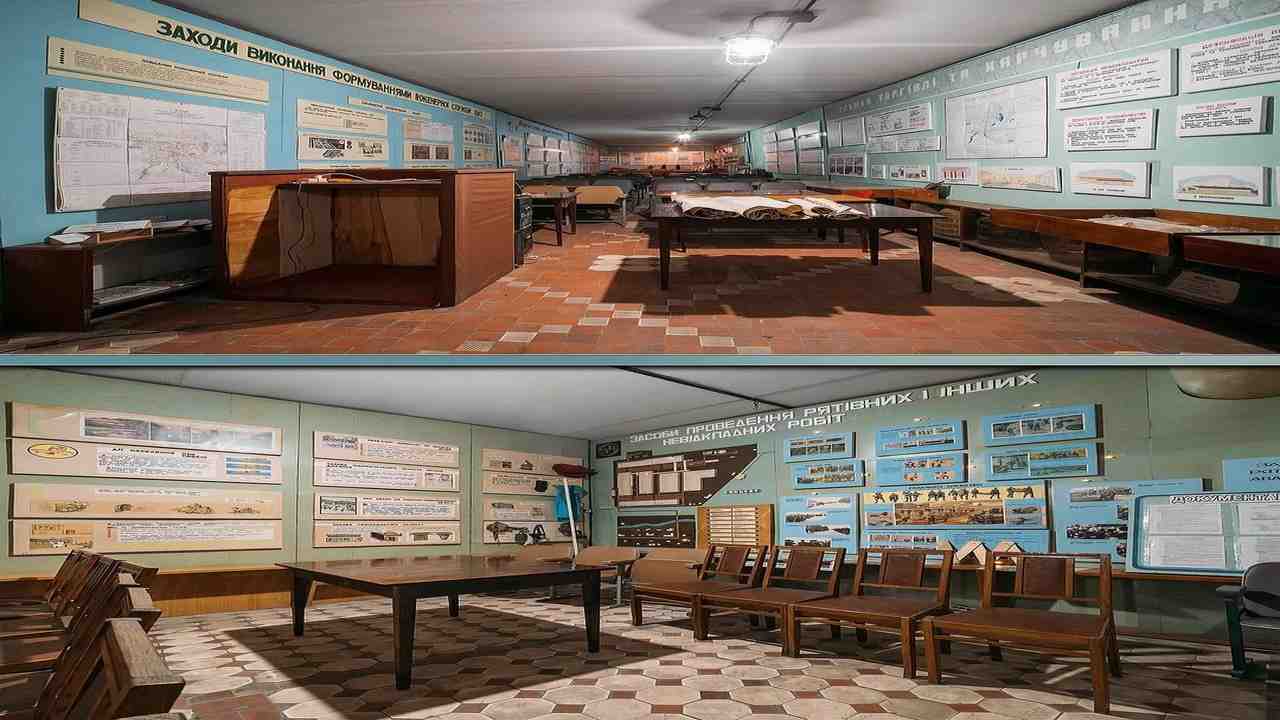The sun beats down mercilessly on rows of silent steel giants, their once-mighty frames now reduced to hollow shells awaiting dismemberment. This is the inglorious end for dozens of German military machines that have found their final parking spot in one of Europe’s most haunting tank graveyards. Marder infantry fighting vehicles, Leopard tanks, and other gutted war beasts stand in formation one last time, their metal carcasses lined up under the open sky in rows that shrink with each passing day.
These mechanical warriors, which once thundered across European battlefields and training grounds, now face complete dismemberment into spare parts. Their steel will soon be recycled—one way or another—marking the end of an era for some of Germany’s most iconic military vehicles.
What Are Military Vehicle Graveyards?
Military vehicle graveyards, also known as tank boneyards or armor graveyards, represent the final destination for decommissioned combat vehicles that have reached the end of their operational life. These sprawling facilities serve as temporary storage and processing centers where retired tanks, armored personnel carriers, and other military equipment await their ultimate fate.
Unlike civilian car junkyards, military vehicle graveyards operate under strict security protocols and environmental regulations. These facilities must carefully manage hazardous materials, including fuel residues, hydraulic fluids, and potentially radioactive components from certain weapon systems. The process of dismantling a single main battle tank can take weeks and requires specialized equipment and trained personnel.
The German military vehicle graveyards have become particularly significant in recent years as the Bundeswehr modernizes its equipment and phases out older systems. The sight of once-formidable Leopard tanks and Marder infantry fighting vehicles reduced to scrap metal serves as a stark reminder of the constant evolution of military technology.



The Rise and Fall of German Military Might
Germany’s military vehicle industry has long been synonymous with engineering excellence and battlefield effectiveness. The Leopard 2 main battle tank, considered one of the world’s finest, has served as the backbone of NATO armor for decades. Similarly, the Marder infantry fighting vehicle revolutionized mechanized warfare when it entered service in the 1970s.
However, the end of the Cold War dramatically altered Europe’s security landscape. Military budgets shrank, and the need for massive tank formations diminished. Germany, in particular, faced pressure to reduce its military footprint and transition from a frontline Cold War defender to a peacekeeping-focused force.
The transformation wasn’t immediate. Throughout the 1990s and 2000s, many German military vehicles remained in service, participating in NATO operations from the Balkans to Afghanistan. But as newer, more advanced systems entered service, older vehicles became surplus to requirements.
The current wave of retirements reflects both technological advancement and changing strategic priorities. Modern warfare increasingly emphasizes mobility, precision, and technology over the brute force represented by heavy armor. Consequently, many of the steel behemoths that once dominated European battlefields have become obsolete.
Inside the Dismantling Process
The journey from operational vehicle to recycled steel involves multiple stages, each requiring specialized expertise and equipment. When a German military vehicle arrives at a graveyard, it undergoes a systematic evaluation to determine its fate.
First, technicians drain all fluids, including fuel, hydraulic fluid, and coolant. These substances require careful handling and disposal according to environmental regulations. Any remaining ammunition or explosive components are removed by qualified ordnance disposal specialists.
Next, valuable components are stripped for reuse or sale. Modern military vehicles contain sophisticated electronics, night vision systems, and communication equipment that retain significant value. These components often find new life in other military applications or civilian uses.
The armor plating, which represents the bulk of a tank’s weight, undergoes careful removal. This process requires industrial cutting equipment and skilled operators who understand the vehicle’s construction. The steel is then sorted by grade and composition, as different alloys command different prices in the recycling market.
Engines and transmissions receive special attention, as these components often contain valuable metals and can sometimes be refurbished for civilian use. The recycling process aims to recover as much material as possible while minimizing environmental impact.
The Economics of Military Scrap
The dismantling of military vehicles represents a significant economic activity, with implications extending far beyond the immediate recycling value. A single Leopard 2 tank contains approximately 60 tons of steel, along with aluminum, copper, and other valuable metals. At current scrap prices, the raw materials alone can be worth tens of thousands of dollars.
However, the economics extend beyond simple scrap value. The spare parts market for military vehicles represents a multi-billion-dollar industry. Components from decommissioned vehicles often provide cost-effective alternatives to new parts, supporting the maintenance of active fleets worldwide.
Some components find unexpected second lives in civilian applications. Tank engines, for example, sometimes power industrial equipment or generators. Armor plating may be repurposed for security applications, while electronic systems can be adapted for civilian use.
The labor-intensive nature of military vehicle dismantling also provides employment opportunities. Skilled technicians, crane operators, and specialized workers find steady work in these facilities, contributing to local economies.



Environmental Considerations and Challenges
The environmental impact of military vehicle graveyards presents both challenges and opportunities. On one hand, proper dismantling and recycling prevent thousands of tons of steel and other materials from ending up in landfills. The recycling process also reduces the need for new metal production, which carries significant environmental costs.
However, military vehicles present unique environmental challenges. Many contain hazardous materials, including asbestos insulation, lead-based paints, and radioactive components from certain weapon systems. These substances require specialized handling and disposal procedures.
The sheer scale of some military vehicle graveyards also raises concerns about soil contamination and groundwater impact. Decades of fuel spills, hydraulic fluid leaks, and other incidents can leave lasting environmental damage that requires costly remediation.
Modern facilities incorporate advanced environmental protection measures, including sealed drainage systems, soil monitoring, and air quality controls. These measures help ensure that the dismantling process doesn’t create new environmental problems while addressing legacy contamination issues.
The Strategic Implications
The presence of tank graveyards across Europe reflects broader strategic shifts in military thinking and international relations. The end of the Cold War eliminated the threat of massive tank battles across Central Europe, reducing the need for large armored formations.
Modern military strategists increasingly emphasize flexibility, speed, and precision over the brute force represented by heavy armor. This shift has accelerated the retirement of older systems and driven investment in new technologies such as unmanned systems and precision-guided munitions.
The dismantling of German military vehicles also reflects changing public attitudes toward military spending and foreign policy. German citizens, scarred by their country’s militaristic past, have generally supported reductions in military capability and spending.
However, recent geopolitical developments have prompted some reconsideration of these policies. The resurgence of great power competition and new security challenges have led to increased defense spending and renewed interest in military capabilities.
International Perspectives on Military Vehicle Disposal
Different countries approach military vehicle disposal in various ways, reflecting their unique circumstances and priorities. The United States, with its vast military-industrial complex, often stores retired vehicles in massive desert facilities, preserving them for potential future use or foreign military sales.
Russia, facing economic constraints and legacy Soviet equipment, has developed extensive scrapping operations that focus on recovering valuable metals and components. The scale of these operations reflects the enormous quantities of military equipment inherited from the Soviet era.
Israel, with its constant security concerns and limited space, has developed innovative approaches to vehicle lifecycle management, often upgrading older platforms rather than scrapping them. This approach maximizes the value of military investments while addressing space constraints.
The European approach, exemplified by the German tank graveyards, emphasizes environmental responsibility and economic efficiency. This reflects broader European values regarding sustainability and resource management.
The Future of Military Vehicle Graveyards
As military technology continues to evolve, the role of vehicle graveyards will likely expand and change. The increasing use of advanced materials, electronics, and autonomous systems in military vehicles will create new challenges and opportunities for the recycling industry.
Future military vehicles may incorporate more recyclable materials and design features that facilitate end-of-life processing. This approach, known as “design for disassembly,” could significantly reduce the environmental impact and cost of vehicle disposal.
The integration of artificial intelligence and robotics into the dismantling process may also improve efficiency and safety. Automated systems could handle hazardous materials more safely and efficiently than human workers, while also reducing labor costs.
Climate change concerns are driving increased interest in the environmental impact of military activities, including vehicle disposal. Future regulations may require more stringent environmental standards for military vehicle graveyards, potentially increasing operational costs but also driving innovation in recycling technologies.



Lessons from the Tank Graveyards
The German tank graveyards offer valuable lessons about military planning, environmental responsibility, and resource management. They demonstrate the importance of considering the full lifecycle cost of military equipment, including disposal and environmental remediation.
The facilities also highlight the challenges of managing large-scale military transitions. The end of the Cold War created enormous quantities of surplus military equipment that required careful management to avoid environmental and economic problems.
Perhaps most importantly, the tank graveyards remind us of the temporary nature of military power and the constant evolution of warfare. The mighty tanks and armored vehicles that once seemed invincible now await dismantlement, their steel destined for recycling into civilian products.
Frequently Asked Questions
What happens to the weapons and ammunition from scrapped military vehicles?
All weapons and ammunition are removed by qualified ordnance disposal specialists before the dismantling process begins. These items are either destroyed according to international treaties or transferred to active military units if they remain serviceable.
Are there any environmental regulations governing military vehicle graveyards?
Yes, military vehicle graveyards must comply with strict environmental regulations governing hazardous waste disposal, soil contamination, and water quality. These facilities are regularly inspected and monitored to ensure compliance.
Can civilians visit military vehicle graveyards?
Most military vehicle graveyards are restricted facilities with limited or no public access due to security concerns and safety hazards. However, some facilities offer limited tours or have museum displays featuring historical vehicles.
How long does it take to completely dismantle a tank?
The complete dismantling of a main battle tank typically takes 2-4 weeks, depending on the vehicle’s size and complexity. The process includes fluid drainage, component removal, armor cutting, and material sorting.
What is the value of a scrapped military vehicle?
The value varies significantly based on the vehicle type, condition, and current metal prices. A typical main battle tank might yield $50,000-$100,000 in scrap metal and components, though specialized systems can be worth considerably more.
Are any parts from scrapped military vehicles sold to civilians?
Some non-sensitive components may be sold to civilian buyers, particularly items like engines, transmissions, and basic mechanical parts. However, weapons systems, armor, and classified technology are strictly controlled.
How do military vehicle graveyards impact local communities?
These facilities typically provide employment opportunities and contribute to local economies through taxes and spending. However, they may also raise concerns about environmental impact and traffic from heavy equipment transport.
What happens to rare or historically significant military vehicles?
Vehicles with historical significance are often preserved for museums or educational purposes rather than scrapped. Military historians and preservation societies work to identify and save important examples for future generations.
Are there international agreements governing military vehicle disposal?
Various international agreements and treaties govern aspects of military vehicle disposal, particularly regarding weapons destruction and environmental protection. These agreements help ensure responsible disposal practices.
How has technology changed the military vehicle scrapping process?
Modern dismantling operations use advanced cutting equipment, automated sorting systems, and sophisticated environmental monitoring. These technologies have improved efficiency and safety while reducing environmental impact.
The inglorious end of German military machines in Europe’s tank graveyards represents more than just the recycling of steel and metal. It symbolizes the end of an era, the evolution of warfare, and the constant cycle of military modernization. As these mechanical giants await their final dismantlement, they serve as silent witnesses to changing times and the temporary nature of military power. Their steel may be recycled into civilian products, but their legacy in military history remains permanent.
![]()






